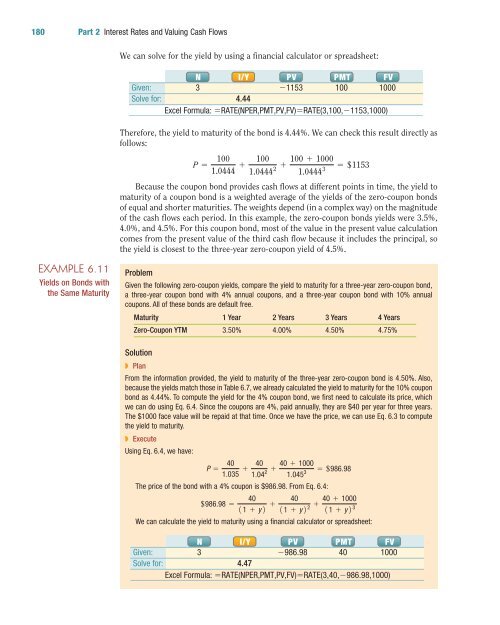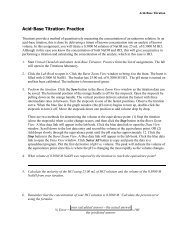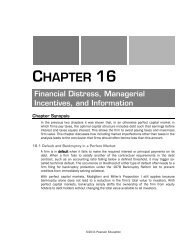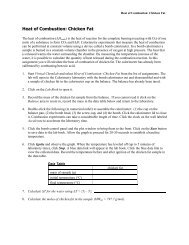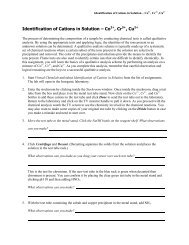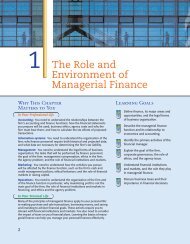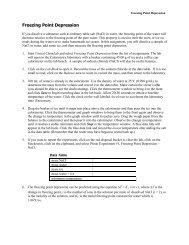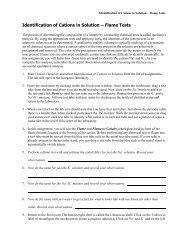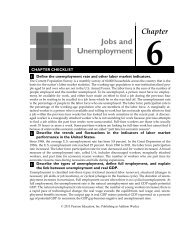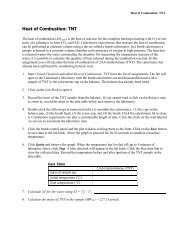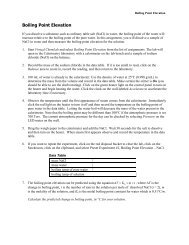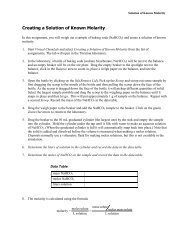Chapter 6 APPENDIX B - Pearsoncmg.com
Chapter 6 APPENDIX B - Pearsoncmg.com
Chapter 6 APPENDIX B - Pearsoncmg.com
Create successful ePaper yourself
Turn your PDF publications into a flip-book with our unique Google optimized e-Paper software.
180<br />
Part 2 Interest Rates and Valuing Cash Flows<br />
We can solve for the yield by using a financial calculator or spreadsheet:<br />
N I/Y PV PMT FV<br />
Given:<br />
3<br />
1153 100 1000<br />
Solve for:<br />
4.44<br />
Excel Formula: RATE(NPER,PMT,PV,FV)RATE(3,100,1153,1000)<br />
Therefore, the yield to maturity of the bond is 4.44%. We can check this result directly as<br />
follows:<br />
P = 100<br />
1.0444 + 100 100 + 1000<br />
+<br />
2<br />
1.0444 1.0444 3 = +1153<br />
Because the coupon bond provides cash flows at different points in time, the yield to<br />
maturity of a coupon bond is a weighted average of the yields of the zero-coupon bonds<br />
of equal and shorter maturities. The weights depend (in a <strong>com</strong>plex way) on the magnitude<br />
of the cash flows each period. In this example, the zero-coupon bonds yields were 3.5%,<br />
4.0%, and 4.5%. For this coupon bond, most of the value in the present value calculation<br />
<strong>com</strong>es from the present value of the third cash flow because it includes the principal, so<br />
the yield is closest to the three-year zero-coupon yield of 4.5%.<br />
EXAMPLE 6.11<br />
Yields on Bonds with<br />
the Same Maturity<br />
Problem<br />
Given the following zero-coupon yields, <strong>com</strong>pare the yield to maturity for a three-year zero-coupon bond,<br />
a three-year coupon bond with 4% annual coupons, and a three-year coupon bond with 10% annual<br />
coupons. All of these bonds are default free.<br />
Maturity 1 Year 2 Years 3 Years 4 Years<br />
Zero-Coupon YTM 3.50% 4.00% 4.50% 4.75%<br />
Solution<br />
◗ Plan<br />
From the information provided, the yield to maturity of the three-year zero-coupon bond is 4.50%. Also,<br />
because the yields match those in Table 6.7, we already calculated the yield to maturity for the 10% coupon<br />
bond as 4.44%. To <strong>com</strong>pute the yield for the 4% coupon bond, we first need to calculate its price, which<br />
we can do using Eq. 6.4. Since the coupons are 4%, paid annually, they are $40 per year for three years.<br />
The $1000 face value will be repaid at that time. Once we have the price, we can use Eq. 6.3 to <strong>com</strong>pute<br />
the yield to maturity.<br />
◗ Execute<br />
Using Eq. 6.4, we have:<br />
P = 40<br />
1.035 + 40 40 + 1000<br />
+<br />
2<br />
1.04 1.045 3 = +986.98<br />
The price of the bond with a 4% coupon is $986.98. From Eq. 6.4:<br />
+986.98 =<br />
40<br />
11 + y2 + 40 40 + 1000<br />
+<br />
2<br />
11 + y2 11 + y2 3<br />
We can calculate the yield to maturity using a financial calculator or spreadsheet:<br />
N I/Y PV PMT FV<br />
Given:<br />
3<br />
986.98 40 1000<br />
Solve for:<br />
4.47<br />
Excel Formula: RATE(NPER,PMT,PV,FV)RATE(3,40,986.98,1000)


